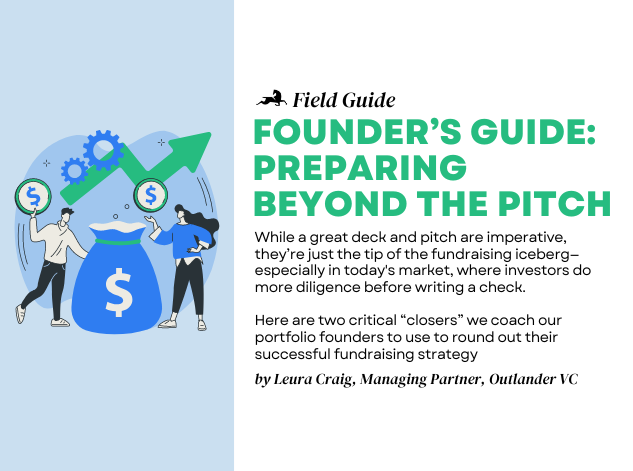Founder’s Guide: Preparing Beyond the Pitch
Posted by: Leura Craig
Posted on 08/30/2023

Posted by: Leura Craig
Posted on 08/30/2023

While a great deck and pitch are imperative, they’re just the tip of the fundraising iceberg—especially in today’s market, where investors do more diligence before writing a check. Since securing a “yes” from investors from an excellent first pitch is unlikely, founders need a 360° fundraising strategy to convert pitches into capital. So, after securing a first meeting and nailing your pitch, here’s how we coach our portfolio founders through the two critical “closers” of a successful fundraising strategy: consistent follow-ups and a robust data room at the ready.
Fundraising is a time-consuming necessity for founders, so being prepped and ready is paramount. Immediately after a pitch, have your first follow-up email queued to send, thanking them for their time and providing access to your data room. Quick responses throughout the fundraising process signal that you are serious about your raise, proactive about potential concerns, and respectful of their time.
At every stage of the raise, your follow-ups should be consistent and professional, acting as an extension of your pitch. Here’s how to wield follow-ups to maximize fundraising efforts:
Every investor operates from a unique investment thesis, which prioritizes different elements of your business accordingly. A robust data room is the most efficient way to quell as many investor concerns as quickly as possible, freeing you up to make more intros, book more meetings, and nail more pitches. Failing to prepare these materials in advance will delay your response to investor concerns, potentially jeopardizing funding.
Your data room has to be secure and accessible by only designated people, such as your potential investors. An impressive data room will show investors that you’ve put time, energy, and thought into how you’re running your business today and how you plan to run your business in the future, including but not limited to:
An initial pitch can only cover so much and dive so deep, so providing supplemental materials shows you’re a prepared, strong operator who has done their homework on the business you’re trying to build. Think of your data room as not only a repository of your financial and operational documents but as a place to illustrate the full breadth of your vision. Include supporting documents that speak to your future vision for the business, such as future product development, future sales or marketing initiatives, and other strategies that you couldn’t cover in your initial pitch deck.
Early-stage investments are a bet on the founding team’s long game. As you court potential investors, part of your job is to build their trust and conviction that you understand the problem you’ve set out to solve and are the right person to build its solution. So, as you implement these follow-up strategies and build your robust data room, treat each piece of outreach or supplemental materials as an extension of your pitch: professional, optimistic, and well-crafted.
And if you’re an exceptional early-stage tech founder building something big, we want to hear. from you! Learn more about Outlander VC’s investment strategy and connect with our investors now.

Leura is a former founder and experienced investor who previously bootstrapped two startups as the founding CEO.
As we explore the unknown of each new investment, our Field Guides are where we document all that we learn along the way.
So, whether you’re actively raising, trying to break into VC, or interested in our game-changing portfolio, our Field Guide's got you covered.
Sign up now for exclusive access to funding opportunities, events/resources from our network of experts, updates from our portfolio, and more!